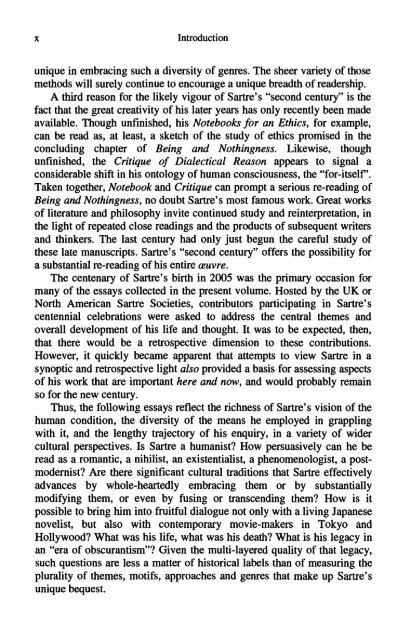Sartre's second century
Sartre's second century
Sartre's second century
You also want an ePaper? Increase the reach of your titles
YUMPU automatically turns print PDFs into web optimized ePapers that Google loves.
X Introduction<br />
unique in embracing such a diversity of genres. The sheer variety of those<br />
methods will surely continue to encourage a unique breadth of readership.<br />
A third reason for the likely vigour of <strong>Sartre's</strong> "<strong>second</strong> <strong>century</strong>" is the<br />
fact that the great creativity of his later years has only recently been made<br />
available. Though unfinished, his Notebooks for an Ethics, for example,<br />
can be read as, at least, a sketch of the study of ethics promised in the<br />
concluding chapter of Being and Nothingness. Likewise, though<br />
unfinished, the Critique of Dialectical Reason appears to signal a<br />
considerable shift in his ontology of human consciousness, the "for-itself'.<br />
Taken together, Notebook and Critique can prompt a serious re-reading of<br />
Being and Nothingness, no doubt <strong>Sartre's</strong> most famous work. Great works<br />
of literature and philosophy invite continued study and reinterpretation, in<br />
the light of repeated close readings and the products of subsequent writers<br />
and thinkers. The last <strong>century</strong> had only just begun the careful study of<br />
these late manuscripts. <strong>Sartre's</strong> "<strong>second</strong> <strong>century</strong>" offers the possibility for<br />
a substantial re-reading of his entire oeuvre.<br />
The centenary of <strong>Sartre's</strong> birth in 2005 was the primary occasion for<br />
many of the essays collected in the present volume. Hosted by the UK or<br />
North American Sartre Societies, contributors participating in <strong>Sartre's</strong><br />
centennial celebrations were asked to address the central themes and<br />
overall development of his life and thought. It was to be expected, then,<br />
that there would be a retrospective dimension to these contributions.<br />
However, it quickly became apparent that attempts to view Sartre in a<br />
synoptic and retrospective light also provided a basis for assessing aspects<br />
of his work that are important here and now, and would probably remain<br />
so for the new <strong>century</strong>.<br />
Thus, the following essays reflect the richness of <strong>Sartre's</strong> vision of the<br />
human condition, the diversity of the means he employed in grappling<br />
with it, and the lengthy trajectory of his enquiry, in a variety of wider<br />
cultural perspectives. Is Sartre a humanist? How persuasively can he be<br />
read as a romantic, a nihilist, an existentialist, a phenomenologist, a postmodernist?<br />
Are there significant cultural traditions that Sartre effectively<br />
advances by whole-heartedly embracing them or by substantially<br />
modifying them, or even by fusing or transcending them? How is it<br />
possible to bring him into fruitful dialogue not only with a living Japanese<br />
novelist, but also with contemporary movie-makers in Tokyo and<br />
Hollywood? What was his life, what was his death? What is his legacy in<br />
an "era of obscurantism"? Given the multi-layered quality of that legacy,<br />
such questions are less a matter of historical labels than of measuring the<br />
plurality of themes, motifs, approaches and genres that make up <strong>Sartre's</strong><br />
unique bequest.
















